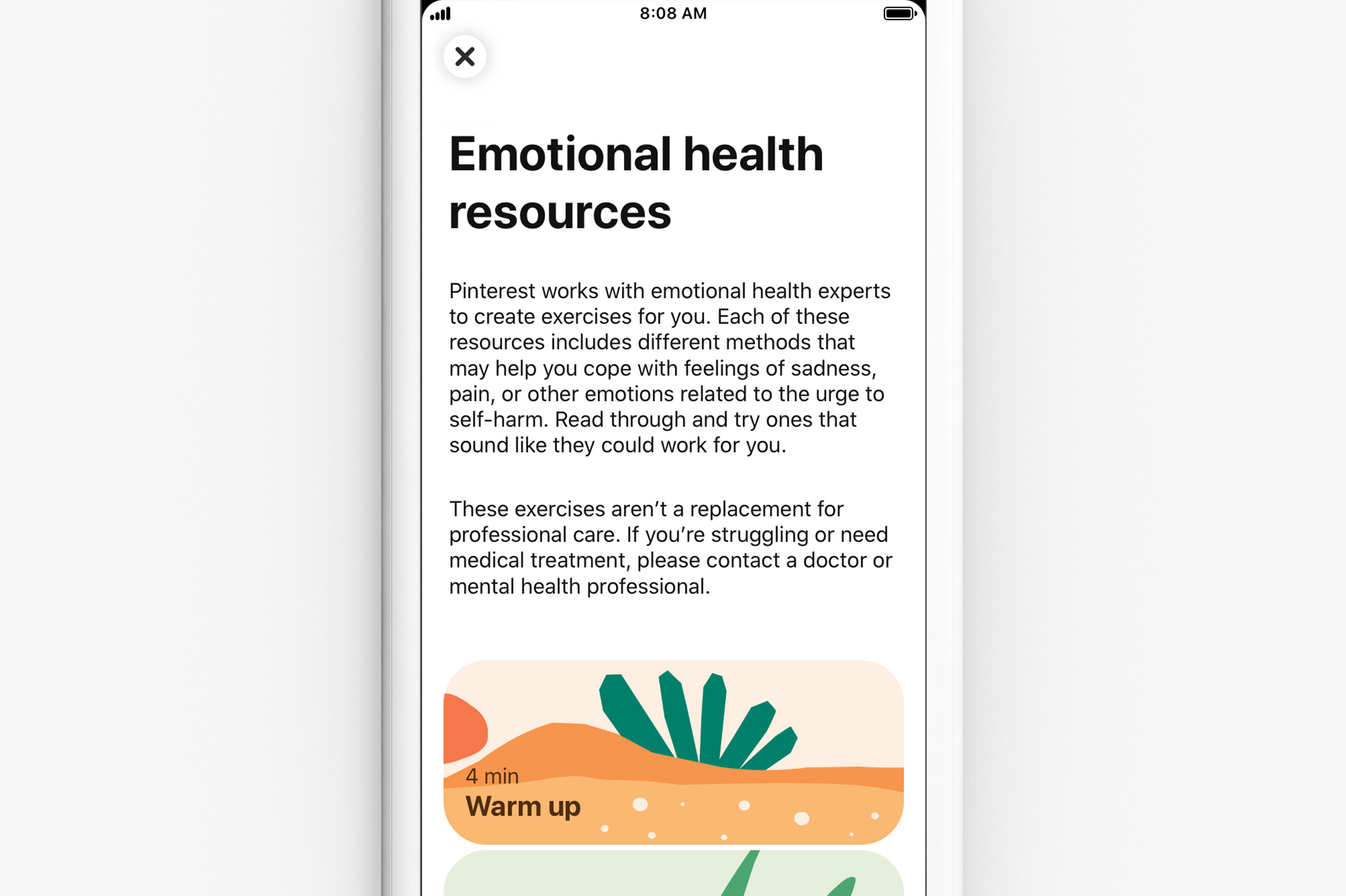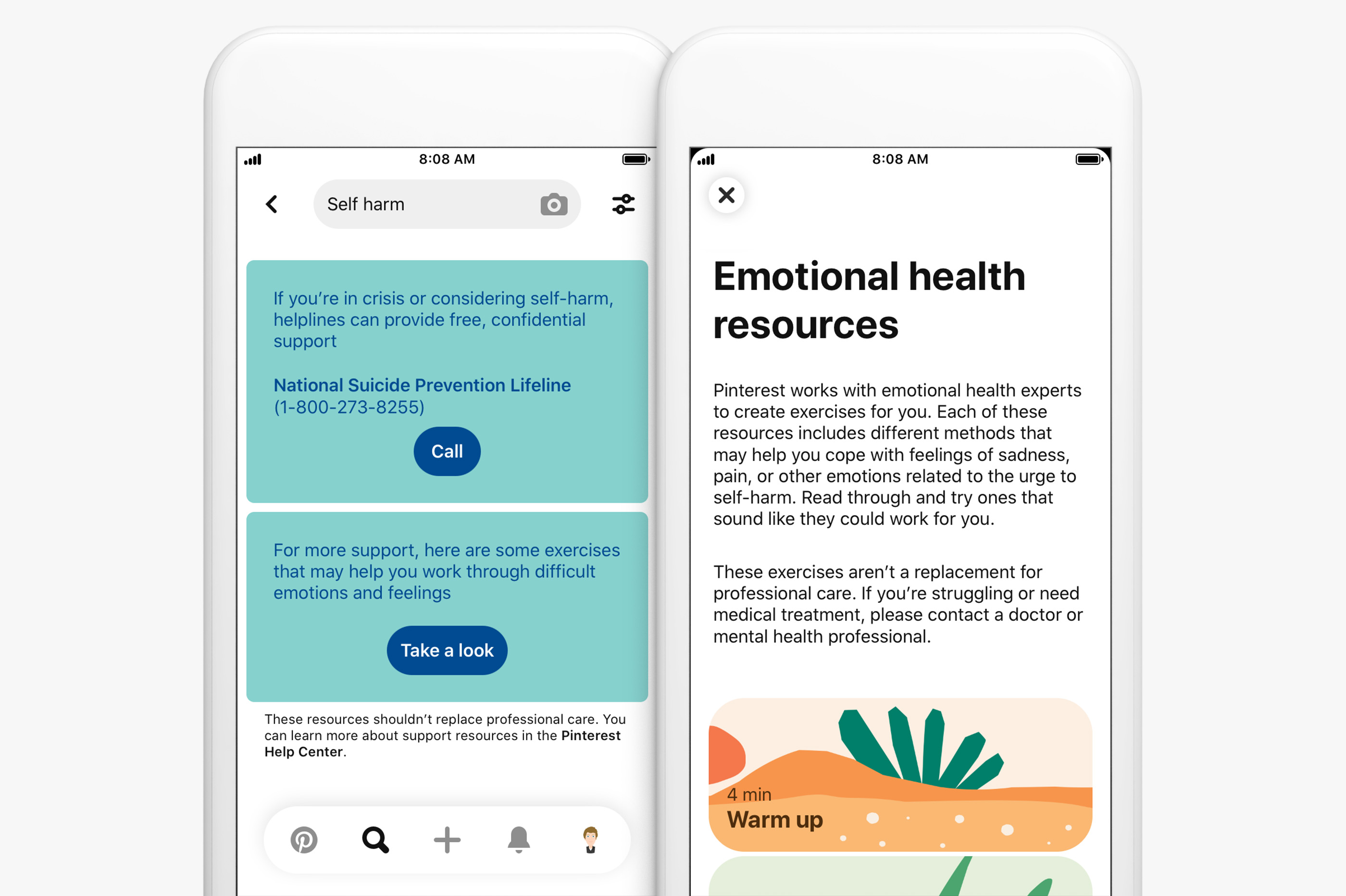New tools for managing difficult emotions

At Pinterest we measure the success of our product not just by what people are doing, but by what people are feeling. A lot of technology today prioritizes behavioral outcomes (“Does it get clicks? Let’s do more of it.”). We believe it’s important to prioritize emotional outcomes. Everything we do is in service of helping people feel more inspired. So when we noticed people in especially low moments were coming to Pinterest to try to feel a little better, we wanted to do more to meet them in whatever mindset they’re in.
That’s why earlier this year we launched a more compassionate search experience with activities people can do to improve their mood. We developed it with emotional health experts at Brainstorm, the Stanford Lab for Mental Health Innovation, and with guidance from Vibrant Emotional Health and the National Suicide Prevention Lifeline. These experts continue to help us better understand different emotional states, including the unique needs of people who search for self-harm. If we can help even one person feel more optimistic, we know that’s time well spent.
Introducing coping exercises to compassionate search
Today we are expanding our compassionate search experience to better support people who are feeling sadness, pain or other emotions related to the urge to self-harm.
Now, if someone searches for a term related to self-injury, they’ll find ten new coping exercises that can help them work through difficult emotions and feelings. Each exercise is guided with steps people can take to manage their feelings, such as ways to redirect energy, release tension or create a calm environment. For example, let’s say you typed in “self hate” and chose the “redirect your energy” activity. It would suggest starting a journal and rereading it a few days later to get some perspective on your thoughts. Or, if writing isn’t your thing, you could try drawing a nature scene or making a playlist.
.gif)
Each activity is evidence-based and comes out of our work with emotional health experts. They aren’t meant to replace professional care, but are carefully designed to help people improve their outlook. People can also access the collection at any time by searching for #pinterestwellbeing in our app.

For people who may be experiencing thoughts of suicide, we continue to provide access to the National Suicide Prevention Lifeline directly from our search results, from the well-being activities page and on boards with content that could signal someone is in emotional distress.

As I know myself, emotional wellness is a personal journey. That’s why Pinterest does not track who uses these exercises. People’s interactions with these activities are stored anonymously using a third-party service so that they won’t be shown related recommendations or ads.
We were also thoughtful about the design of the experience, making sure it felt separate from Pinterest itself. We used gentler colors to create a sense of harmony and calmness, and specially designed the UI to keep people’s focus on the resources. We also used a fullscreen approach that uses optimized typography to make the activities easy to read and follow.
Along with developing these resources, we’ve dramatically improved our ability to catch and remove content related to self-harm. Our machine learning technologies are increasingly identifying and hiding this content before anyone sees it. As a result, reports of this content from Pinners decreased by 88 percent over the last year.
A more positive internet
I hear from a lot of Pinners that they come to Pinterest to do something–cook a recipe, plan a vacation. But people also come to feel something. Quotes are the third most popular search term on all of Pinterest as people look for words to help them feel more inspired (“inspirational quotes” is #22), comforted (“life quotes” is #34) and motivated (“motivational quotes” is #38). We have a responsibility to recognize how and why people use our service and build experiences that help them feel more positive when they leave.
Because sometimes you need more than an inspirational quote. Through our work with mental health experts, we’ve learned a lot about trying to meet our Pinners in whatever emotional state they’re in. The reality is that more Americans are reporting symptoms of depression. Seven in ten teens see depression and anxiety as major problems among their peers. And when it comes to self-harm, a recent study showed that nearly 18 percent of U.S. teens reported harming themselves at least once during the previous year. Those rates are even higher among teenage girls, affecting about one in four in some parts of America.
For some of the most painful emotional experiences–urges to self-injure or thoughts of suicide–most tech platforms are good at connecting people to crisis hotlines. But there’s a gap between urges to self-injure and thoughts of suicide. Experts confirm that these are different emotional states, and they require different solutions–most people who injure themselves are often not suicidal in the moment, and instead are looking for a way to cope with their emotions.
The exercises we created bridge that gap–offering new ways for someone to reduce their stress levels in the moment, and giving them tools they can use on a regular basis to cope with their emotions. And if they ever need access to crisis prevention support, it’s readily available from our app.
These new activities are available to Pinners in the U.S. today in our apps for iOS and Android (version 7.37 and above). We are working to bring the experience to more Pinners in more places soon.
Evan Sharp, co-founder and chief creative & design officer